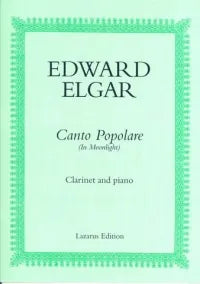Syrinx Music
Elgar, E - Canto Popolare (In the Moonlight) for clarinet and piano
Elgar, E - Canto Popolare (In the Moonlight) for clarinet and piano
Couldn't load pickup availability
Edward Elgar (1857-1934)
Canto Popolare (In Moonlight)
"---a little chapel by a group of pine trees, Classical in style, like a temple, it was falling into ruin and the sudden impact of its beauty silenced us". Relating the events of a January afternoon with the Elgar family in the Vale of Andorra in 1904, Rosa Burley describes the composer's inspiration for the Concert Overture In the South (Alassio), which was performed in March of that year at the three-day Elgar festival at Covent Garden. The unexpected appearance of a passing shepherd completed the picture, and led to the inclusion of the simple folk-like tune, Elgar's own, which forms the interlude at the heart of this work.
By the end of the year Elgar had given this tune a life of its own, firstly as a song, setting Shelley's words "As the moon's soft splendour" under the title In Moonlight, and then as a salon piece entitled Canto Popolare. Like the popular Salut d'Amour it appeared in numerous instrumental versions from small orchestra to piano solo, including violin, viola, cello and clarinet. The arrangements for violin, cello and clarinet, like that for small orchestra, are in F major. The viola version is in C major, the key in which the tune appears in the overture. Slight discrepancies between the two piano parts suggest that at least one of these was arranged by someone other than Elgar, and this has permitted some minor tidying-up of phrasing in the present edition.
Elgar did, however, send corrected proofs - presumably scores as well as parts - to Jaeger on 29 September 1904, noting that he had himself phrased the clarinet part and requesting Jaeger's wife (the violinist Isabella Donkersley) to edit the others. In the event the names of three of Elgar's professional colleagues - Alfred Hobday (viola), W.H. Squire (cello) and Charles Draper (clarinet) - appeared on the printed parts, though in the last case at least the words "edited by" seem hardly to have been justified. Draper's contribution was to suggest that the piece would lie better on the clarinet in A natural rather than on the clarinet in B flat, and the part was accordingly re-engraved. Draper's judgement, however, was a personal one, and in this edition the part has been printed for both B flat and A clarinets, leaving the performer a choice.
Share


